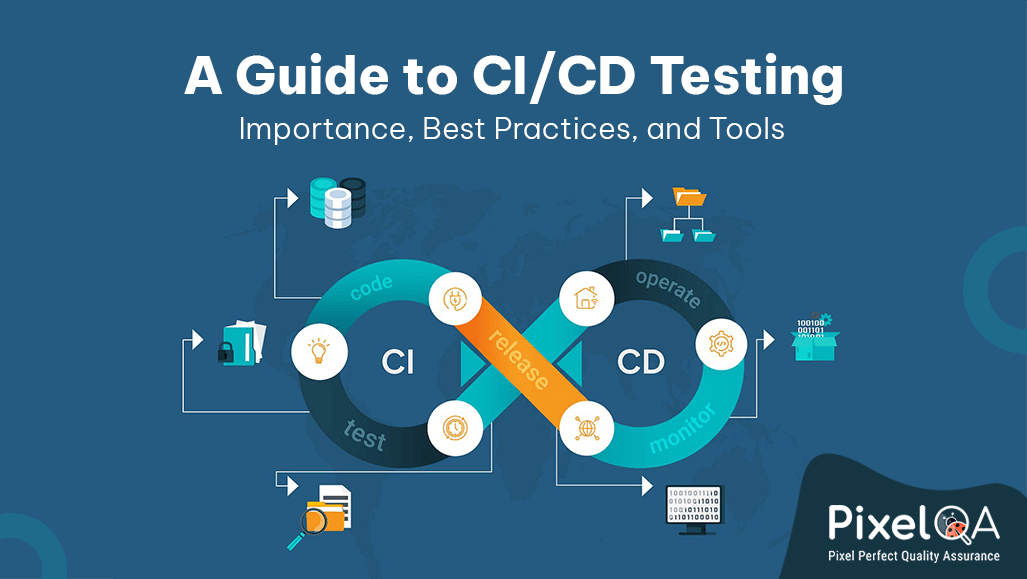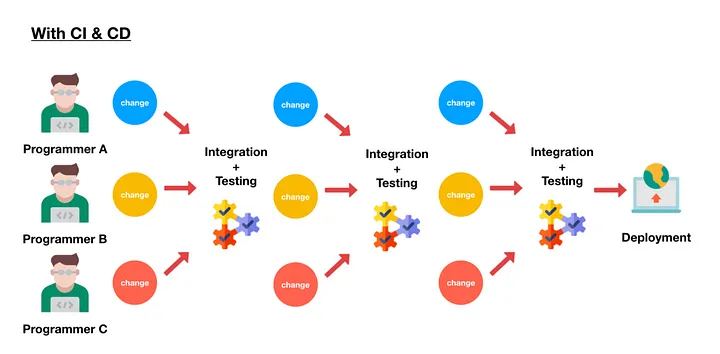
From the execution perspective, CI/CD has become the key practice for delivering quality software with speed and scale. Unless maintained under strong testing processes in this dynamic environment, the effectiveness and dependability of these CI/CD pipelines would be called into question. Therefore, Integration Testing Services in these pipelines test component interactions to assure comprehensive functionality before deployment.
This article will furnish you with useful tips and practical guidance for implementing CI/CD testing in your software development process, irrespective of your proficiency. So, let's not go around in circles but instead get right into it!
Table of Contents
- What is CI/CD Testing?
- Why is CI/CD Testing important?
- Best Practices for CI/CD Testing
- Tools and Technologies for CI/CD Testing
- CI/CD Security Best Practices
- Conclusion
What is CI/CD Testing?
CI testing, the main part of the DevOps approach, is the process of merging code modifications into a shared repository and then running automated tests against it. This process is also called continuous integration/continuous deployment and consists of a collection of automated steps that allow for better deployment processes for new iterations of software and services. CI and CD are thus essential parts of the software development lifecycle.
The importance of CI/CD in DevOps is essential, as it makes it possible the smoothening software development processes. A CI/CD pipeline is meant mainly to boost the delivery of software with easier workflows. The role of automation in reducing human errors and ensuring consistency throughout the software release cycle is crucial.
CI/CD involves continuous development activities and the ability to release software updates at any time. The goal of the CI/CD pipeline is essentially to enable teams to continuously and smoothly deliver small software improvements to production, thereby:
- Quicken release cycles
- Lower costs
- Reduce the risks associated with development
- Enable continuous delivery
- Ensure software quality and security
- Create happier customers
- Lower strain on development
Continuous Integration and Continuous Deployment (CI/CD) are strongly connected with DevOps and agile because these methodologies all work toward a common goal: rapidly producing high-quality results through flexible means.
Continuous integration (CI), which is perhaps the most notable part of DevOps, advocates for developers to frequently merge their code changes into a central repository such that automated builds and tests can be run. On the other hand, CD encompasses the actual deployment of code.
Why is CI/CD Testing important?
In modern software development, continuous integration and deployment (CI/CD) are essential practices. They enable smooth integration of code updates and ensure rapid delivery of applications to production environments. This methodology is crucial because:
Reduce errors
CI/CD fosters collaboration among development, testing, and operations units, thus mitigating the likelihood of miscommunication and reducing errors.
Improve code quality
CI/CD can help to achieve faster release cycles and ensure better code quality.
Get products to market faster
CI/CD allows organizations to ship software quickly and efficiently, and continuously deliver code into production.
Fix problems before release
CI/CD can enhance the quality of the developed software and fix all problems before its immediate release.
Best Practices for CI/CD Testing
Here are some best practices for CI/CD testing:
Automated testing
This process aids developers in detecting and rectifying issues at an early stage of development, enabling them to intercept bugs and flaws prior to deployment.
System integration
This ensures proper alignment between operations and developers.
Single source repository
This enhances collaboration, promotes consistency, simplifies version control, reduces the risk of conflicts, and makes it easier to track changes.
Version control
This is key to a successful CI/CD pipeline and allows the team to review application and infrastructure configuration code.
Automated builds
This helps developers get the test results within minutes, which helps them work on the defects or key issues straight away.
Continuous Delivery
This allows software development teams to automate deployment steps and ensure code quality. Continuous testing and frequent code deployments are both critical elements of the approach.
Compliance as code
This involves codifying compliance requirements and policies and automating their validation as part of the CI/CD pipeline.
Tools and Technologies for CI/CD Testing
- GitLab: A Git repository manager with tools for tracking issues, reporting, and an online wiki. It integrates with popular services like Slack and Jira.
- Harness: An AI-powered platform that lets users build, test, deploy, and verify software on demand. It integrates with all primary DevOps tools.
- Jenkins: Jenkins is an open-source server platform that helps in carrying out automation tasks by distributing jobs across multiple workstations. It supports well-known cloud services like Amazon Web Services, Google Cloud, Microsoft Azure, and Digital Ocean.
- Bamboo Data Center: A commercial tool that helps automate build management.
- Code Ship: A cloud-based tool that integrates with tools developers already know.
- CircleCI: A flexible tool that prioritizes security and supports rapid software development and publishing. You can integrate CircleCI with GitHub, GitHub Enterprise, and Bitbucket to create builds when new code lines are committed.
- Semaphore: A fully customizable tool that emphasizes enterprise-level security.
- Travis CI: Travis CI is a widely recognized CI/CD service that profoundly accelerates coding and deploying by virtue of its automation and advanced alert-generation schemes.
- Buddy: A creative CI/CD solution for web developers that helps in transitioning to DevOps more easily. It builds, tests, and deploys applications using delivery pipelines composed of over 100 ready-to-use activities that may be assembled in any.
CI/CD Security Best Practices
- Automated testing: Helps identify and fix issues early in development.
- Dynamic analysis security tests: Examines code from the outside in its running state, like what a hacker would do.
- Monitor pipelines: Data collected from monitoring solutions makes it easier to debug complex failures.
- Isolate CI/CD systems: Place them in secure internal networks/storage.
- Commit code frequently: It helps to keep your team members informed of any changes and makes it easier to detect issues quickly.
- Continuous security: The operations team can see improved stability as rollback procedures are automated and environments have standard configurations.
- Rollback: Design for fast and reliable rollbacks from the beginning.
- Secure the code repository: To protect your code repositories, your access credentials or service can be compromised by malevolent attackers, who can manipulate the source code at their own will.
Conclusion
General principles, best practices, and suitable tools and technologies can improve team workflows, code quality, and time-to-market. CI/CD is not just about automation; it is about the collaboration, security and value provided to both developers and end-users. As organizations adopt DevOps and agile methodologies, some improvements will be realized in the integration of CI/CD practices, which remain a cornerstone to ensure quality software is delivered consistently and efficiently, when a Software Testing Company could be partnered with.
After reading this post, if you're willing to improve your development process, then partner with us and access the best Automation Testing Services and deliver out-of-the-box software with confidence.
About Author
Vedant Parmar is a veteran QA executive who believes in continuous learning, training, and acquiring new skills. He wants to pursue a career in Mobile Test Automation and Penetration Testing, and strives to be a QA manager in his professional journey.



